Article categories:
Select a category below to view articles on each subject.
Search
Enter your keyword/s below to search :

Fish delivered straight to your door from Wildwoods
Hundreds of Species available today…
TFF Mailing List
Join the TFF mailing list today and we will email you with latest offers, news items and more.
Visit to Maidenhead Aquatics@ St Albans
Maidenhead Aquatics at St Albans is sometimes described as the flagship store in the Maidenhead Aquatics chain. It is certainly one of the largest, with hundreds of display tanks including dedicated systems for soft water fish and marines alongside the usual community tropical and coldwater tanks. The store also features an exceptionally large dry goods area for aquarium and pond supplies, as well as an outdoor section for pond plants and ornaments.
Maidenhead Aquatics at St Albans is located on the North Orbital Road (A414) just west of the junction with the London Road. There's lots of car parking next to the store. By bus, routes 84, 602 and 659 call at the St Peters Street stop on the London Road, about 6 minutes walk away from the store. By train, Park Street on the St Albans Abbey line from Watford and St. Albans City on the Thameslink line from London are both about a 20-25 minute walk away.
Barbs and danios
On our visit to Maidenhead Aquatics at St Albans this week we saw a good variety of small cyprinids including a number of interesting barb and danio species. The little Galaxy Danio Danio margaritatus is an exceptionally popular species noted for its small size and bright colours. At no more than 2 cm long when fully grow it's an ideal species for small tanks down to about 30-40 litres, and while a bit small to keep with standard community fish, particularly midwater species, but very small bottom-feeding companions such as Corydoras hastatus or Cherry Shrimps can make excellent companions. Water chemistry is not a critical issue provided extremes are avoided, but they don't like being kept too warm, which is one reason Corydoras and algae shrimps make such excellent tankmates. Aim for around 10 degrees dH hardness, around neutral pH, and a water temperature between 20 and 24 degrees Celsius.
A less frequently seen danio species was Danio dangila, sometimes known as the Moustached Danio because of its exceptionally long barbels. All danios have barbels, but they are usually rather short and difficult to see, but this species is quite different in this regard. Otherwise it's a fairly typical large danio that needs a roomy tank with well-oxygenated water that isn't too warm. Realistically an aquarium 180 litres in size or large would be necessary for a group of six or more specimens of this sociable but rather boisterous species. As with most danios, they aren't fussy about water chemistry, but the water temperature should be on the cool side, 20 to 24 degrees C. Water movement in the tank should be brisk, turnover rates of at least 8 times the volume of the tank per hour being highly recommended. Mature fish are handsome, robust animals that would make ideal dither fish for fast-water cichlids, loaches and catfish.
Among the barbs we saw at Maidenhead Aquatics at St Albans, one of the species we particularly liked was Barbus jae, a small West African species only rarely offered for sale. The species is sexually dimorphic, with the females being brownish with vertical bands while the males are red with bluish-black vertical bands. This species comes from cool, shady rainforest pools and is best kept in a species tank where the water is soft, slightly acidic, and not too warm; 1-10 degrees dH, pH 6.0-7.0, and 20-24 degrees C are the recommended parameters for successful maintenance. Provided lots of overhead shade in the form of floating plants, and decorate the bottom of the tank with bogwood and shade-tolerant plants such as Anubias and Java ferns. If companion fish are added, choose species that share similar requirements, particularly with regard to water temperature. This species is tricky to maintain and not recommended for beginners, but in good condition is an excellent and highly attractive fish well worth keeping.
Tetras and other characins
Maidenhead Aquatics at St Albans is unusual in maintaining a dedicated soft water section where South American characins can be held in the optimal water chemistry they need for long term success. It should be noted that while things like Neons and Cardinals may tolerate hard water for a while, the local water chemistry in this part of England doesn't really suit them, and health problems can be a serious issue for South American characins over the long term.
With all this said though, there are a few South American tetras that will adapt to "London Tap" and some of these are among the best community fish there are. The most notable of them is the excellent X-Ray Tetra, Pristella maxillaris, a species Maidenhead Aquatics at St Albans regularly keeps in stock. Not only will it adapt to water chemistry conditions between 1-20 degrees dH, pH 6-8, it also happens to be completely peaceful and extremely attractive. It is also very hardy, and one of the best tetras for absolute beginners. If kept in groups of 6 or more, this species is very unlikely to cause any serious problems, and should live for 4-5 years without any great effort on the part of the fishkeeper. Do note though that it has delicate colours that will only develop properly in shady, well-planted tanks, and when kept in open, bare tanks with bright light X-Ray Tetras can look a bit washed out. It also happens to look particularly good when schooling together in large groups, so buying at least a dozen is well worth the effort. Luckily, these fish are farmed in huge numbers and never expensive.
Slightly more difficult to maintain is the Golden Pencilfish, Nannostomus beckfordi, but it is still quite an adaptable species, especially compared to other Pencilfish. Water chemistry should be soft to moderately hard, slightly acidic to neutral; aim for 2-10 degrees dH, pH 6.5-7.5. Groups of 6 or more should settle in community tanks nicely if kept with other small, peaceful fish such as Cardinal Tetras, Marbled Hatchetfish and Corydoras sterbai.
Among predatory characins, we were pleased to see Maidenhead Aquatics at St Albans had some young Hujeta Rocket Gar, Ctenolucius hujeta, in stock. Though not as well-known as Piranhas, these fish are much easier to keep and make far better aquarium residents. They are medium-sized pike-like characins that have proven to be very adaptable in terms of water chemistry, doing perfectly well in both soft and hard water provided extremes are avoided. They get to about 15-20 cm in length and ignore tankmates too large to swallow in a single bite. They are somewhat sociable so are best kept in twos or threes. Feeding isn't a big problem here. While live earthworms and river shrimps are enjoyed, they're easily weaned onto dead foods including small pieces of prawn and fish fillet, and once settled, sometimes take floating foods such as Hikari cichlid pellets.
Catfish
On our visit to Maidenhead Aquatics at St Albans we were particularly impressed by the range of African catfish including numerous Synodontis. At the smaller end of the range was the infrequently-seen Big-Eye Synodontis, Synodontis pleurops. As its name suggests, this species has proportionally larger eyes than most other Synodontis, and frankly, this is a fair reflection of its strongly nocturnal habits. In most ways this species requires the same care as the more often kept Dwarf Upside-Down Catfish Synodontis nigriventris. Soft to moderately hard water is acceptable, and the species does well across a broad water temperature range. It does of course expect to be kept in a tank with lots of shade, and floating plants can be particularly helpful here by encouraging the fish to take shelter at the top of the tank where it can be more easily observed. Once settled down though small groups of three or more specimens will make excellent additions to a community tank, though it shouldn't be kept with tiny species likely to be viewed as food, or with unusually slow and long-finned species such as Veil-Tail Angelfish.
Among the big African cats, none are as well-liked as the Giraffe Catfish Auchenoglanis occidentalis. A couple of these were on sale at Maidenhead Aquatics at St Albans. While few aquarists will have the 750+ litre aquarium needed to maintain this species properly, those that do have big tanks will find this catfish hardy, peaceful and full of character. It's basically an omnivore so will eat very tiny fish, but gets along great with appropriate tankmates including jumbo cichlids such as Oscars and Frontosas. Water chemistry tolerances are broad, and this species is known to occur in wide range of habitats from rainforest streams through to Lake Tanganyika.
We also saw lots of South American cats on sale, including a good variety of Corydoras and L-number plecs. One of the rarer L-numbers that we spotted in the display tanks was the Panaque cf. nigrolineatus, also known as the Broken-Line Royal Plec or Dull-Eyed Royal Plec, L191. As the first of these names suggests, this species resembles the standard Royal Plec Panaque nigrolineatus but the black squiggles on its body are much more broken. It also has grey rather than red eyes. Maximum length appears to be towards the low end by the standards of the Royal Plec species group, around 25 cm being typical. As such, this would be a good addition to community tanks upwards of 250 litres. Royal Plecs are generally very hardy and adaptable once settled in, but can be delicate at first, and need plenty of fresh green foods and algae wafers to get them fattened up nicely.
Cichlids
Maidenhead Aquatics at St Albans has a very large cichlid section that is particularly strong in Rift Valley species and Central American species. Since these come from hard water areas, they're particularly well suited to Southern England, and so long as nitrate levels are kept low, maintenance in local water conditions shouldn't cause problems. Among the Tanganyikans, we were pleased to see lots of "Julies", Julidochromis species. All of these are fairly small fish, and though territorial, they hardy ever stray far from their chosen cave, so pairs will cause few problems in properly stocked Tanganyikan communities. In fact they generally ignore everything other than other Julidochromis species, which makes adding a singleton or a pair of Julidochromis particularly unproblematic. One of our favourite species is Julidochromis dickfeldi, a species that only gets to about 8 cm long and features delicate dark horizontal bands on a pale cream-coloured body together with electric blue trimmings to its unpaired and ventral fins.
One of the more unusual cichlids on sale during our visit was Paretroplus menarambo, a species from Madagascar. These cichlids are rather large, the largest specimens know about 25 cm long, though aquarium specimens tend to top out at about 20 cm. They have the same deep-bodied shape as things like Severums. Body colouration varies from bluish-grey to pearly-pink, and the flanks are covered with numerous small dark spots. The unpaired fins are tinged with pink or red. The tail fin is deeply forked and has a rather crescent-like shape, and at first glance Paretroplus menarambo has an almost marine quality to its appearance. Sadly, the species is extinct in the wild, a threat that hangs over the fortunes of most of the Madagascan cichlids, but it is a very beautiful and fairly peaceful species that can work well in robust cichlid communities. Public aquaria usually maintain this species alone though, in groups of six or more specimens, so that its natural behaviour can be more easily observed. Sexual dimorphism is minimal, so rearing groups is the best way to allow pairs to form. Like most Madagascan cichlids, this species is fairly adaptable in terms of water chemistry, though moderately hard, around neutral to slightly basic conditions would be ideal.
Oddballs
There were lots of unusual fish on sale during our visit, including such favourites as the Black Ghost Knifefish, Pygmy Puffers and Asian Glassfish. Several brackish water species were in stock too, including the excellent Silver Scat, Selenotoca multifasciata, a species noted for its brilliant silvery-white body colour ornamented with vertical rows of black stripes and spots. Typically reaching a total length of 20 cm or so under aquarium conditions, this species is boisterous but peaceful, and makes a good companion to things like Archerfish, Monos and Colombian Shark Catfish. It may also be kept with saltwater fish, working particularly well in FOWLR systems where its outgoing personality can encourage shyer species to spend more time in the open. Although extremely hardy given appropriate conditions, it doesn't do well in freshwater indefinitely, and brackish water conditions with a specific gravity upwards of SG 1.003 will be required for long-term success.
We also saw lots of young Polypterus delhezi on sale. These are among the prettiest of the Bichirs, and with a body length of around 35 cm when fully grown, they aren't too demanding in terms of space. As with other Bichirs they are territorial and can be snappy towards one another, but they are otherwise easy-going and adapt well to community life alongside fish of similar size, provided of course that their tankmates are neither nippy nor aggressive, as bichirs tend to be easy targets for fin-nippers and bullies. Feeding isn't hard, with earthworms and shrimps being particular favourites, but chunks of seafood and fish fillet readily accepted as well.
Other fish articles:
Other fish articles you may be interested in are listed below, click an article for full details.
-
FISH ARTICLE
-
FISH ARTICLE
-
FISH ARTICLE
-
FISH ARTICLE






.jpg)
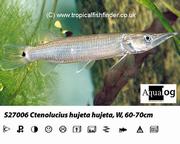
.jpg)
.jpg)
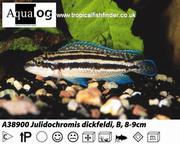
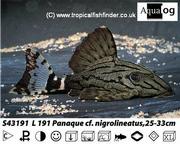
.jpg)
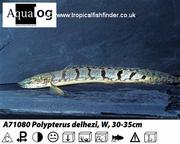
.jpg)
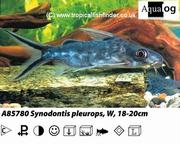
.jpg)
